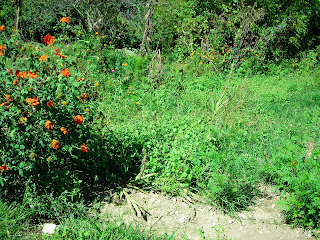In Oak Dale Cemetery in Urbana,
Ohio, stands a splendid monument to Simon Kenton (1755–1836). In 1777, Kenton
saved the life of his friend Daniel Boone. Kenton served as a scout for
Europeans and was captured by Shawnee during the year 1778. Kenton served as a
scout for George Rogers Clark during the American Revolutionary War (1775–1783)
and with “Mad” Anthony Wayne during the Northwest Indian War (1793–1794). As a
Brigadier General, Kenton reprised his rôle as scout—and led a militia
group—during the Battle of the Thames in 1813.
 |
| Statue of Simon Kenton in Urbana, Ohio |
In 1997,
donations paid for a life-size statue replicating a smaller one by famous
Urbana sculptor John Quincy Adams Ward (1830–1910). The sculpture stands atop a
stone plinth, or base, erected in 1884.
 |
Sculpture
by John Quincy Adams Ward
Commemorating
the Sculptor
Elsewhere
in Oak Dale Cemetery
|
The
monument is well worth a visit, as imposing and somber as it is. While Eleanor
Y. Stewart and I looked at the statue on a weekday morning in the summer,
additional visitors arrived.
Page 39 of
the History of Allen County, Ohio
(Chicago: Richmond & Arnold, 1906) says, “In the forests of Ohio Kenton had
confronted Indians, bears, wolves and panthers. On the south face of the
monument is carved, life-size, the head of an Indian chief … ; on the west face
is the head of a bear, as life-like as stone can be, and appearing as if the
head had just been thrust through the face of stone; on the north side is the
head of a wolf similarly carved; and on the east side is the head of a panther.
The design is by J. Q. A. Ward, the celebrated sculptor, now of New York, but a
native of Urbana. His grandfather originally owned the land on which Urbana is
built, and for many years the elder Ward and Kenton were intimate friends.”
 |
| Bear on Simon Kenton Monument |
I will
vouch for the lifelike qualities of the heads thrusting forward from the sides
of the grand base. It was a little difficult for me to photograph the faces
because they engaged me in what could be described as confrontations.
 |
| Panther |
 |
| Native American |
 |
| Wolf |
I leave it
to qualified historians to sort out the complicated issues separating the real
Simon Kenton from the legendary one. While I studied the Kenton monument, I
admired the work of J. Q. A. Ward, whose statues capture life in ways that I,
as an illustrator, can admire but cannot produce. Ward was an exceptional
artist!
Wandering
away from the solemn shadow of the monument, Eleanor Y. Stewart and I found a
bur oak nearby. We collected several acorns to present to the squirrels in
Eleanor’s yard back home. Finding the choicest acorns in the sunny grass took
our minds off the menacing heads protruding from the Kenton monument. By the
time we had hauled our harvest to the car, we had resumed our cheerful,
chattering selves.





